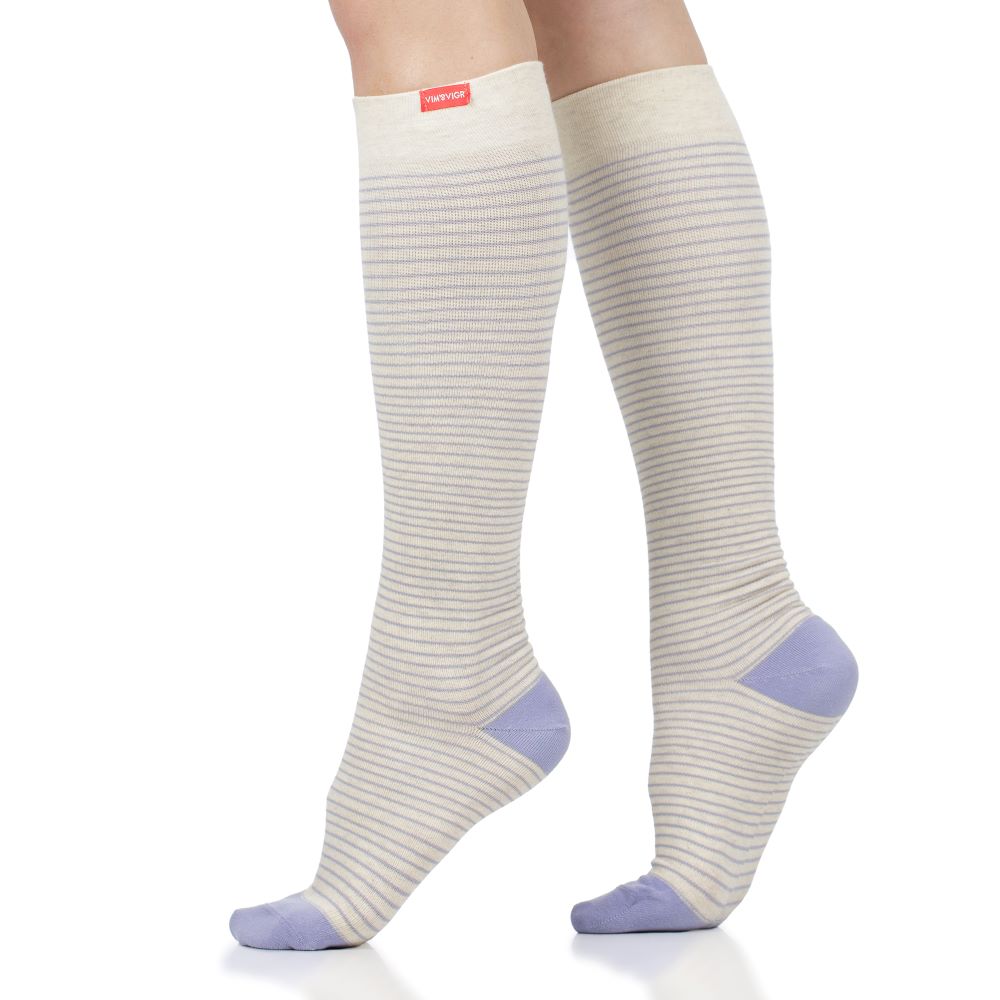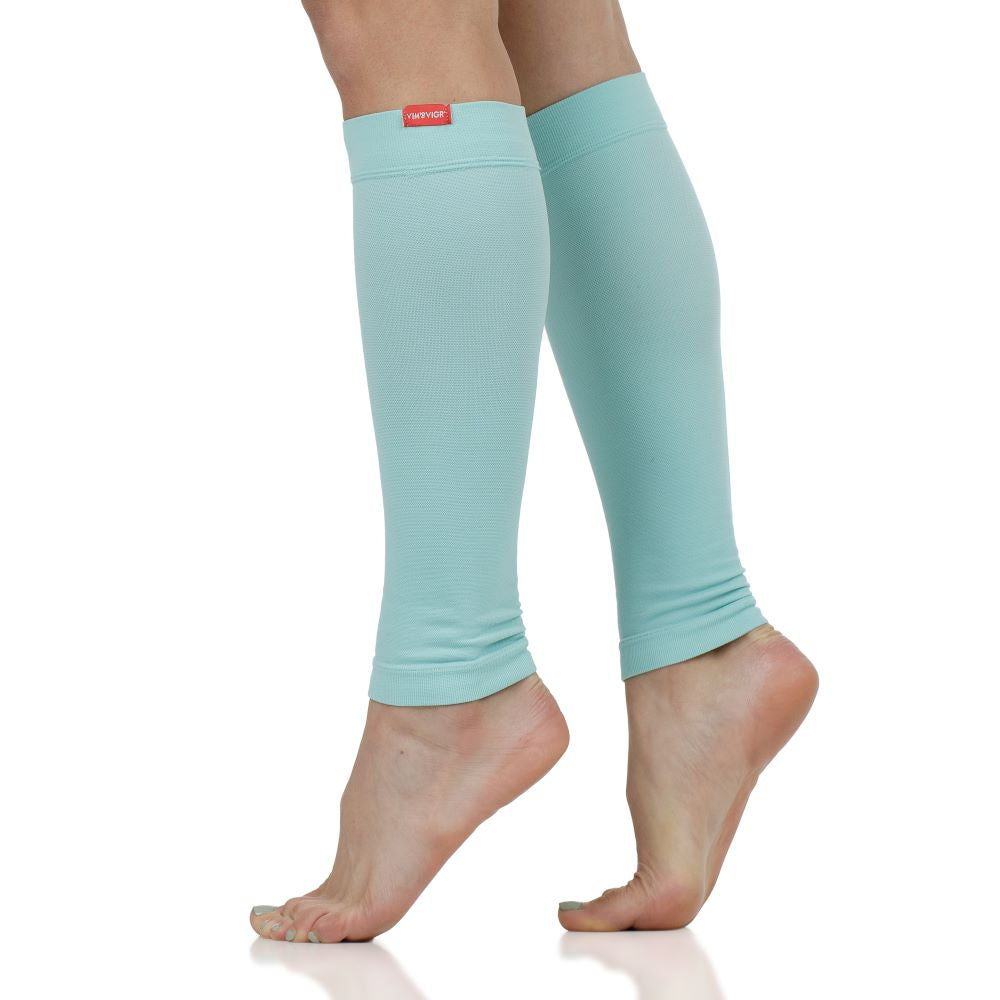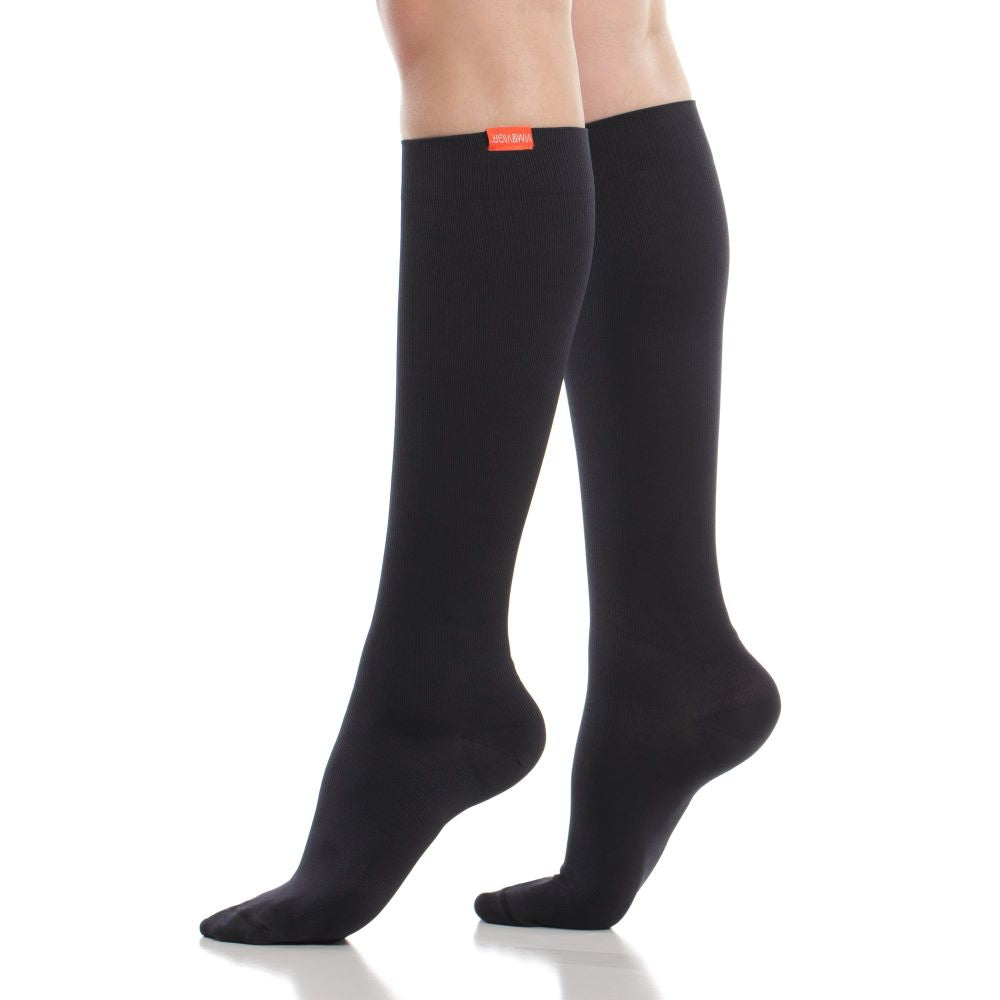Exploring Compression Socks for Tendonitis: Stepping Into Relief
From our feet to our legs, tendons are crucial for our stability and wellbeing. They connect the muscles, help with flexibility, and provide much needed support whether running, playing sports, or walking. But, what happens when we over-solicit the tendons and end up injured?
Overused or solicited tendons become inflamed and sore - this is what’s called tendonitis. It can occur in many different areas, from the back of the leg to the area just at the front of the ankle, to knees and hamstrings. Luckily, a lot of cases of tendonitis can be treated with rest and compression. And compression, along with a considered, gradual approach to exercise, can also help reduce the risk of tendonitis in the first place.
In this article, we’ll look at how compression socks help tendonitis injuries. Read on to find out how you can use compression garments to manage and alleviate pain, reduce the time it takes to recover from tendonitis, and prevent it over the long term (or avoid getting injured again).
Are Compression Socks Good for Tendonitis?
Compression socks provide a multi-faceted approach to managing pain from lower leg tendonitis, while also helping reduce the risk of injury. They support the muscles and tendons, which reduces impact from sports such as running, basketball, or tennis. And, through the boost in blood flow that compression socks provide, they help bring down swelling and inflammation, speeding up recovery and offering pain relief.
How Compression Socks Work for Tendonitis
Thanks to their dual action in boosting blood flow and massaging the lower legs, compression socks deliver a multitude of benefits when you suffer from tendonitis. Here are the ways they’re good for various tendon injuries.
Reduced Swelling
Boosting peripheral circulation means that blood flows more freely in the lower legs. This helps reduce inflammation and swelling, which is caused by the local buildup of fluid.
When you’re suffering from extensor tendonitis, for example, the inflammation in your feet will cause the area to swell up. Providing a soothing massage to the foot and increasing the blood circulation upwards towards the heart, compression socks can help reduce this swelling. They can also help prevent swelling caused by a buildup of fluid when you’re immobile - for example, while resting after a tendon injury.
Improved Blood Flow
Graduated compression socks are tighter at the lower end, slowly releasing pressure as they climb towards the knee. The gentle pressure that’s applied stimulates blood flow up towards the heart, reducing the risk of it pooling around the ankles (or of other fluid buildup). This has a positive effect on overall body circulation, while reducing swelling and inflammation. It can also help you feel more energized and “light on your feet” after exercise.
Enhanced Muscle Support
With the pressure applied by compression socks, there’s an added feeling of support and protection to the muscles and tendons. This is why they can feel really helpful when you’re recovering from tendonitis, further protecting the tendons. Compression socks also help reduce pressure on the tendons from overstretched muscles, for example supporting the calf muscles so they’re not pulling too much on the Achilles tendon. This will reduce the risk of tendonitis developing.
Pain Relief
A lot of the pain related to tendonitis comes from the swelling and inflammation in the affected area. Through improved blood flow and massage, compression socks reduce these symptoms and provide relief from pain at a very localized level. Additionally, the boost in blood flow increases local temperature. This extra warmth also helps soothe sore tendons and muscles.
Prevention of Further Injury
It’s common for runners and athletes who’ve suffered from tendonitis in the past to keep wearing compression socks during their sport to prevent more injuries. Weakened tendons benefit from more support from compression garments, while supporting the muscles in the lower legs means that the tendons will be under less pressure in general, reducing the risk of them getting re-injured.
Accelerated Recovery
Studies show that compression socks speed up recovery after exercise, thanks to the increased blood flow. This leads to nutrients and oxygen being transported to the muscles more quickly and efficiently, which reduces muscle soreness and fatigue. In the case of tendons, an increase in blood flow helps reduce inflammation and swelling, cutting down on how long you feel sore and uncomfortable.
Understanding the Causes and Symptoms of Tendonitis
Tendonitis refers to all inflammations of a tendon in the body. Tendons are thick tissues that attach bones to muscles and they can become inflamed through injury, overuse, or sometimes, when calcium deposits develop in the affected part of the body. The most common cause of tendonitis among athletes is overuse - caused by ramping up training disproportionately quickly or by too much volume of training.
So, how can you tell if you have tendonitis? For most people, the first sign is simply pain in the relevant part of the body, especially while using that joint or muscle (e.g., an inflamed Achilles’ tendon will lead to pain at the back of the lower leg, almost in line with the ankle).
It’s important to distinguish between muscle and tendon pain. When you’ve had a muscle strain, you’ll feel pain within the muscle itself. With tendonitis, the pain is located at the point where the muscle connects with the bone.
Where is tendonitis most likely to occur? You’re more at risk of developing tendonitis in the shoulder, wrist, elbow, knee, and ankle. Many sports players and athletes struggle with conditions such as tennis elbow, swimmer’s shoulder, golfer’s elbow, and the seemingly ubiquitous Achilles tendonitis in the case of runners.
Which Types of Tendonitis Can Benefit from Compression Socks?
Since tendonitis can affect various parts of the body, it can be treated and managed with different tools and types of clothing. For the lower legs, compression socks and leggings provide relief from pain and swelling and can accelerate recovery. The key is that the body part targeted can be covered by the compression garment.
Achilles Tendonitis
Many runners are affected by Achilles tendonitis at least once in their lives. This injury occurs when the Achilles tendon, which connects the calf muscles to the heel bone, is over-solicited. It can also affect tennis or basketball players, especially casual players who may not train enough and then put a lot of strain through their tendons when they play a game at the weekend, for example. Compression socks are effective at reducing inflammation and swelling caused by Achilles tendonitis. They are also supportive and can help reduce the risk of re-injury during recovery.
Posterior Tibial Tendonitis
When one of the tendons on the inner side of the ankle gets damaged, you can develop posterior tibial tendonitis. You’ll feel foot and ankle pain, there’s likely to be swelling along the tendon, and you can start to have an unsteady gait and a hard time pointing your toes inward. Wearing compression socks as you rest and recover will boost blood flow to the area to drive down inflammation. When you return to walking or running, compression socks will also improve the ankle stability and prevent your ankles from swelling and putting added pressure on the tendon.
Peroneal Tendonitis
Peroneal tendons connect the lower leg to the foot on the outer side of the ankle. Both are instrumental in turning out the foot and stabilizing you during runs and sideways movements (such as when playing team sports or tennis). When you over-solicit these tendons, you can get peroneal tendonitis - where the outside of the ankle will hurt and you’ll get swelling, rendness, or warmth around the tendon.
This is a less common injury, but can be treated just like the other cases of tendonitis with rest, physical therapy, and compression (unless it becomes very serious and you may need a soft cast or boot to immobilize the tendon). Compression socks are essential in boosting blood flow to speed up recovery and reduce swelling in these cases, too. They are also good for extra stability during your return to activity.
Extensor Tendonitis
Finally, there are a number of tendons running along the top of your foot, connecting the foot and ankle to the lower leg. When you walk and run, these extensor tendons are in charge of managing the motion of lifting the foot. They can be injured through overuse, as well as with incorrect form when running or when you wear inadequate shoes. Whilst it’s not the same thing as shin splints, they are very similar in that they both cause pain at the front of the leg and can lead to swelling.
Wearing compression socks can address the swelling and bring down inflammation thanks to the boost in blood flow. When you’re returning to exercise, wearing them can give extra support to the ankle and the extensor tendons. Moreover, compression socks help reduce the impact of micro-vibrations in the muscles, produced by repeated landings when running, especially on hard surfaces. This is why they are great for preventing shin splints and can provide extra support in the case of extensor tendonitis, too.
Hamstring Tendonitis
It’s worth mentioning two more types of tendonitis that don’t occur in the lower leg, but which are strongly linked to the same activities that lead to the injuries mentioned above.
As the name suggests, hamstring tendonitis is the result of inflamed tendons at the back of your thighs (hamstrings). These can be injured through overuse or overstretch of the tendons, but the good news is that you can usually recover from it with rest. For a little more support, compression tights cover the whole length of your legs while also stimulating blood flow in the injured area.
Patellar Tendonitis
This type of tendonitis affects the patellar tendon, which is situated between the kneecap (patella) and the shin bone (tibia). This tendon connects to the muscles at the front of the thigh and can become overused when playing sports that involve jumping (like basketball). It also affects runners, especially those that run on trails and uneven terrain. Compression helps support the patella and reduce local inflammation, but you will most likely need to wear compression tights to get an appropriate amount of coverage and pressure on the injured area.
Choosing the Best Compression Socks for Tendonitis
Although tendonitis can vary depending on the area of the body that’s affected and your activity levels, lower leg cases can benefit from the boost in circulation and the additional support from compression socks. But, how do you choose the best ones for you? Here’s a quick guide.
Types of Compression Socks to Consider
It goes without saying that lower leg tendonitis cases will benefit from traditional knee-high compression socks. These give you enough coverage and support for the feet, ankles, calf muscles and shins. Graduated compression socks are tighter around the feet and ankles and gradually loosen up towards the knee, which helps improve peripheral circulation and reduces swelling and the risk of fluid buildup.
However, you can also consider open-toe compression socks if you want to style them with sandals or need access to your toes. These will be just as effective for Achilles, posterior tibial, peroneal or extensor tendonitis cases.
Finally, if you suffer from patellar or hamstring tendonitis, you need to reach full-leg coverage from compression tights.
Sizing and Fit
It’s essential that your compression garments fit well and apply pressure to the lower legs, in order to get their benefits. Follow a sizing guide to ensure you’re not wearing your socks too loose or too tight.
Another point to consider is how your socks fit when you put them on. They should be wrinkle and knot-free, without bunching, so that you’re as comfortable as possible. Always make sure your toes and heels are nestled well into the material and that your socks reach just below the knee, too.
Level of Compression
Not all compression socks are the same - there are different levels of compression, which means multiple levels of how much pressure is applied to your limbs. First-time wearers and those looking to prevent injury and boost blood flow on a regular basis can reach for the lightest, everyday-wear socks (15-20 mmHg).
If you need more support, your doctor may recommend firmer socks that are effective for patients who may already have a medical condition linked to the circulatory system. And, for those coming back from surgery or with more advanced conditions, there are also medical-grade socks which are only available with a prescription.
How to Use Compression Socks for Tendonitis
The best way to use compression socks for tendonitis is to start slowly, listen to your body, and adjust depending on how much pressure you can put up with. The length of time you wear them for, or the frequency, can change over time.
When Should You Wear Them?
Runners and other athletes can wear compression socks to warm up their muscles and tendons before exercising, during their training or racing to prevent injury and add some support, or afterwards to boost recovery. It’s really up to you when you wear them, depending on comfort or activity levels. Additionally, while you recover from tendonitis, wearing compression garments will feel more supportive and reassuring as you return to exercise.
Outside of sports, you can wear compression socks on an everyday basis if you work in an office and sit for long periods of time, or if your daily activities involve standing for hours on end. You can also reach for your compression socks when you unwind after a long day, to reduce swelling and inflammation.
How Long Should You Wear Them
There’s no set limit of time for wearing compression socks for tendonitis. The key thing is to start with a couple of hours at a time if you’re new to wearing compression items, then slowly increase depending on how long you feel comfortable with. How long it will take to see results can also vary depending on your situation and your injury.
Caring for Your Tendonitis Compression Socks
Compression socks need to be washed in a gentle wash, with no added bleach or strong detergents, so they don’t lose their elasticity and the pressure they apply to muscles and tendons. You should also not put them in the dryer: leave your socks to air dry naturally.
We recommend washing your compression socks after every wear and avoiding putting them on if you’ve just applied lotion on your legs, since that can damage the materials.

























Leave a comment